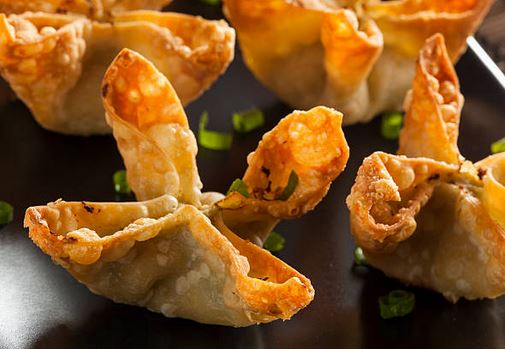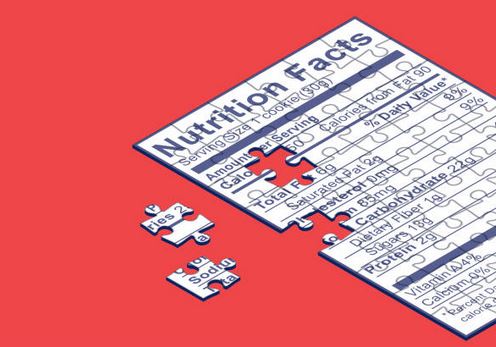Crispy and savory, crab rangoons are a popular dish in many Asian restaurants. But are crab rangoons gluten-free? Sadly the answer is usually no.
While it’s possible to make a gluten-free version, crab rangoons contain gluten in many sit-down and take-out restaurants. Making them at home isn’t much better as most crab rangoon recipes don’t make any effort to be gluten-free; though we’ll have more to say about that later.
Crab rangoons contain gluten, but this mainly comes from crispy wrappers and imitation crab meat. Gluten in wrappers isn’t a surprise, and because most wrappers use wheat flour this is the biggest source of gluten in this dish.
But imitation crab? Unfortunately, most imitation crab meat uses starch as a binder. While starch is mostly gluten-free it will often contain small amounts. For people with serious sensitivities to gluten, starch can sneak in enough gluten to trigger unpleasant reactions.
As people become more aware of gluten and its dangers, some restaurants are offering gluten-free versions of popular dishes.
If you’re eating out it can help to ask the staff if they have a gluten-free crab rangoon alternative. While the answer may be no, asking can help restaurants know there is a demand from customers for more gluten-free menu items.
Table Of Contents:
Crab Rangoons And Gluten – The Real Truth
While most crab rangoons do contain gluten it’s possible to make gluten-free versions with some simple ingredient substitutions.
Restaurants and home cooks can swap out wrappers and imitation crab meat with gluten-free alternatives. Sadly, these changes can alter the texture of the final dish and may increase costs. Unless a restaurant is committed to providing gluten-free dishes they will often take the cheapest option first.
Wrappers are the biggest source of gluten in crab rangoons. Most wrappers are made with wheat flour and contain lots of gluten. This is easy to solve by switching to wrappers made with rice flour. Rice doesn’t contain gluten and is a source of gluten-free flour that can benefit many dishes including crab rangoons.
Imitation crab meat, which often uses a starch binder, is a source of small amounts of gluten. The solution here is to use real crab meat instead. Real crab meat is gluten-free and has better flavor. Unfortunately, it’s more expensive than the imitation version and isn’t common in most crab rangoon recipes.
Real crab meat can be found pre-packaged or removed from crab legs. If you’re getting crab meat from crab legs make sure you know how long crab legs last in the refrigerator.
back to menu ↑
What Do Crab Rangoons Contain?

Every crab rangoon recipe is different but most contain wrappers, crab meat, cream cheese, and spices including Worcestershire sauce or soy sauce. Both Worcestershire sauce and soy sauce can contain gluten unless a gluten-free version is used. Some crab rangoon recipes include green onions and sesame oil, and both of these ingredients are gluten-free.
Most restaurant versions of crab rangoons won’t use fancy recipes, but this isn’t always true. Making crab rangoons at home can let you choose gluten-free ingredients and save money on eating out. Home-made crab rangoons can be as simple or as fancy as you want, and most filling mixes will keep for a few days in the refrigerator.
You can save final assembly and cooking until you are ready to enjoy this treat. Doing this lets you split one batch across multiple days and be sure of great final results each time.
Crab rangoons are often deep-fried and will contain oil from frying. It’s possible to use an air fryer for a healthier version. You’ll want a quality air fryer to give your crab rangoons the right amount of crispiness. If you’re eating out, most crab rangoons will contain oil but this isn’t a source of added gluten.
back to menu ↑
Crab Rangoons Nutrition Facts

Crab rangoons have different nutritional profiles depending on each unique recipe and preparation method. Ask at the restaurant, or read the box if you’re buying crab rangoons in your local grocery store’s frozen section. If you’re making crab rangoons at home, many recipes include detailed nutritional information.
To give you a general idea of the nutritional profile of crab rangoons here are the details for a popular commercial brand: Sea Cuisine Crab Rangoons. This brand contains gluten so expect some differences with gluten-free alternatives.
- Serving size: 84 grams
- Calories: 230
- Protein: 8 g
- Fat: 10 g
- Carbohydrates: 27 g
- Sodium: 420 mg
- Saturated Fat 5 g
- Cholesterol 45 mg
- Sodium 420 mg
- Dietary Fiber 1g
- Sugars 1g
- Iron 1.4mg
- Calcium 20mg
- Vitamin A 120mcg
- Vitamin D 0mg
As you can see, crab rangoons aren’t exactly a healthy food but they’re an amazing snack when you have the craving! Home-made, gluten-free crab rangoons can be the perfect alternative side dish to compliment your dinner plans. Try pairing crab rangoons with this wonderful San Tung Chicken Wings Recipe. Note this recipe uses soy sauce, which isn’t normally gluten-free. Use a gluten-free soy sauce to make this recipe work with your dietary needs.
back to menu ↑
Conclusion
Crab rangoons are a popular Asian restaurant staple, but they aren’t usually gluten-free. People with gluten sensitivities will want to avoid this food, but it’s possible to make gluten-free crab rangoons. Asian restaurants who are serious about catering to gluten-conscious customers have easy ways to make gluten-free versions.
Most of the gluten content in crab rangoons comes from the wrappers. Wheat flour wrappers are a popular choice, but rice flour wrappers can be substituted as these don’t contain gluten.
Wrappers aren’t the only source of gluten: many imitation crab meat products contain starch as a binder. Starch can have leftover gluten which makes any dish containing this product unsafe for people with gluten intolerance. Real crab meat is a pricey, yet delicious, alternative that is totally gluten-free.
Finding gluten-free crab rangoons in a restaurant can be difficult, but making them at home is easy! Some gluten-free recipes exist which give gluten-intolerant people the chance to enjoy this delicious dish safely. Home-made crab rangoons can be deep-fried or cooked in an air fryer as a healthier alternative.
Making this popular dish at home gives you the chance to try different recipes and ingredients, allowing you to create the perfect crab rangoon for your family’s unique taste!
back to menu ↑
Frequently Asked Questions
Do Crab Rangoons have wheat in them?
Crab rangoons often use wheat flour wrappers. As a gluten-free alternative, they can be made with rice flour wrappers. Wrappers aren’t the only possible source of wheat: imitation crab meat uses starch as a binder. This starch can come from a variety of sources, and wheat is on that list.
back to menu ↑
Do Crab Rangoons have dairy?
Cream cheese is a dairy product and an important part of crab rangoons. If you’re looking for a dairy-free alternative they can be made with vegan cream cheese instead.
back to menu ↑
Do Crab Rangoons have eggs?
Some crab rangoon recipes include egg as a binder for the crab and cream cheese. Eggs aren’t present in all crab rangoons, so you’ll need to ask before ordering if you have an egg allergy or are avoiding eggs for other reasons.
back to menu ↑
Is this a Chinese or Japanese dish?
Crab rangoons are likely an American development and aren’t either Chinese or Japanese. Sources point to the origin as being Trader Vic’s, a popular Polynesian-themed restaurant chain. Further evidence against a Chinese origin is the fact that cream cheese doesn’t exist in Chinese cuisine.
back to menu ↑
Is Crab Rangoon dip gluten-free?
Crab rangoon dip is often made with imitation crab meat and wheat flour wonton crisps; both of these items contain gluten. If you’re making your own home-made crab rangoon dip it’s easy to make a gluten-free version by using real crab meat instead of imitation and using wonton crisps made with rice flour.
back to menu ↑
How long are Crab Rangoons good for?
Like all deep-fried foods, crab rangoons will loose their crispness after frying. Sometimes you can reheat refrigerated rangoons in an air fryer and get acceptable results. This doesn’t apply to commercially frozen crab rangoons which have cooking instructions and produce a crispy treat when prepared correctly.
The filling mix for crab rangoons will keep for a few days in the refrigerator. If you’re creating a home-made version it’s possible to save final assembly and cooking till the last minute. That way you’re sure to get crispy and delicious results; and can split one batch up over several days.
References:
- https://www.carbmanager.com/food-detail/md:5dfea47b2fdaac0b5413e6d5c7a5e2bd/crab-rangoons
- https://en.wikipedia.org/wiki/Crab_Rangoon
Shanny
Shanny not only has an exceptional understanding of the foodie mindset and how nutrition works, she has also achieved her Master’s Degree in Education. Outside of her academic achievements, she loves writing food blogs. It's so much more than a list of meals though! Shanny creates helpful cookware guides and delicious recipes that are easy to follow. She does all of this as a food blog writer because she loves it. That's why she spends lots of time testing out different recipes in her own home. She truly is a one-of-a-kind foodie, from her home to yours - with a story to tell, new recipes to indulge in and new tips to tantalize those tastebuds.












